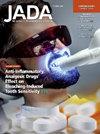Upper airway changes after mandibular advancement surgery combined with minimal maxillary displacement
IF 3.1
2区 医学
Q1 DENTISTRY, ORAL SURGERY & MEDICINE
引用次数: 0
Abstract
Background
The purpose of this study was to analyze airway volume and minimum cross-sectional area (CSA) in a postsurgical follow-up period of at least 12 months in patients after mandibular advancement surgery with minimal maxillary displacement compared with nonsurgical patients with Class I malocclusions (control group).
Methods
The study sample included 14 patients in the surgical group and 14 patients in the control group. Linear, angular, area, and volume measurements were obtained to characterize the sample and assess the outcomes. Comparisons were made among measurements taken before treatment, at least 1 month after surgery, and at follow-up at least 12 months after surgery.
Results
Substantial anteroposterior changes in the mandible and hyoid bones, with minor maxillary movement, were observed. Pharyngeal airway volume increased considerably after surgery, maintaining stability, yet there were no substantial changes observed in the velopharynx and oropharynx. The minimum CSA increased in the postsurgery period and was maintained in the follow-up. Results of correlation analysis revealed negative associations between hyoid displacement and changes in pharyngeal airway volume and CSA. This suggested that when the hyoid bone shifted forward in the anteroposterior direction, it was correlated with an enlargement in pharyngeal airway dimensions.
Conclusions
The greatest increase was seen in pharyngeal airway total volume and CSA, and these changes were stable in the follow-up period.
Practical Implications
Mandibular advancement surgery with minimal maxillary displacement may lead to significant and stable increases in pharyngeal airway dimensions, benefitting patients with narrower pharyngeal airways and potentially higher risk of breathing disorders.
下颌前移手术合并上颌小位移后上呼吸道的改变
本研究的目的是分析在至少12个月的随访期间,下颌骨推进手术后上颌移位最小的患者与非手术的I类错颌患者(对照组)的气道体积和最小横截面积(CSA)。方法选取手术组14例,对照组14例。获得线性、角度、面积和体积测量来表征样品并评估结果。比较治疗前、术后至少1个月和术后随访至少12个月的测量结果。结果观察到下颌骨和舌骨有明显的前后变化,上颌有轻微的运动。术后咽气道体积明显增加,保持稳定,但舌咽和口咽未见明显变化。最小CSA在术后增加,并在随访中保持不变。相关分析结果显示舌骨移位与咽部气道容积和CSA的变化呈负相关。这表明,当舌骨在前后方向向前移动时,它与咽气道尺寸增大有关。结论咽部气道总容积和CSA增加最大,且在随访期间变化较为稳定。实际意义下颌前移手术与最小上颌移位可能导致咽气道尺寸显著和稳定的增加,使咽气道狭窄和呼吸障碍潜在风险较高的患者受益。
本文章由计算机程序翻译,如有差异,请以英文原文为准。
求助全文
约1分钟内获得全文
求助全文
来源期刊

Journal of the American Dental Association
医学-牙科与口腔外科
CiteScore
5.30
自引率
10.30%
发文量
221
审稿时长
34 days
期刊介绍:
There is not a single source or solution to help dentists in their quest for lifelong learning, improving dental practice, and dental well-being. JADA+, along with The Journal of the American Dental Association, is striving to do just that, bringing together practical content covering dentistry topics and procedures to help dentists—both general dentists and specialists—provide better patient care and improve oral health and well-being. This is a work in progress; as we add more content, covering more topics of interest, it will continue to expand, becoming an ever-more essential source of oral health knowledge.
 求助内容:
求助内容: 应助结果提醒方式:
应助结果提醒方式:


